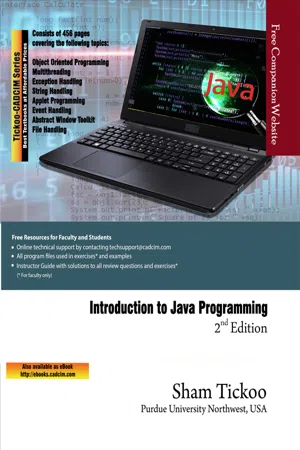
Introduction to Java Programming, 2nd Edition
Prof. Sham Tickoo
- English
- ePUB (disponibile sull'app)
- Disponibile su iOS e Android
Introduction to Java Programming, 2nd Edition
Prof. Sham Tickoo
Informazioni sul libro
Introduction to Java Programming is a textbook for software developers to familiarize them with the concept of object-oriented programming (OOP). The textbook enables the reader to understand the basic features of Java. The line-by-line explanation of the source code, a unique feature of the textbook, enables the students to gain a thorough and practical understanding of Java. The chapters in this book are structured in a pedagogical sequence, which makes this textbook very effective in learning the features and capabilities of the software.
The following are some additional features of this book: >
- Each concept discussed in the book is exemplified by an application to clarify and facilitate better understanding.
- This textbook introduces the key ideas of object-oriented programming in an innovative way.
- The concepts are illustrated through best programs, covering the basic aspects of Java.
- Additional information is provided to the users in the form of notes.
- There is an extensive use of examples, schematic representation, screen captures, tables, and programming exercises.
Table of Contents
Chapter 1: Introduction to Java
Chapter 2: Fundamental Elements in Java
Chapter 3: Control Statements and Arrays
Chapter 4: Classes and Objects
Chapter 5: Inheritance
Chapter 6: Packages, Interfaces, and Inner Classes
Chapter 7: Exception Handling
Chapter 8: Multithreading
Chapter 9: String Handling
Chapter 10: Introduction to Applets and Event Handling
Chapter 11: Abstract Window Toolkit
Chapter 12: The Java I/O System
Index
Domande frequenti
Informazioni

